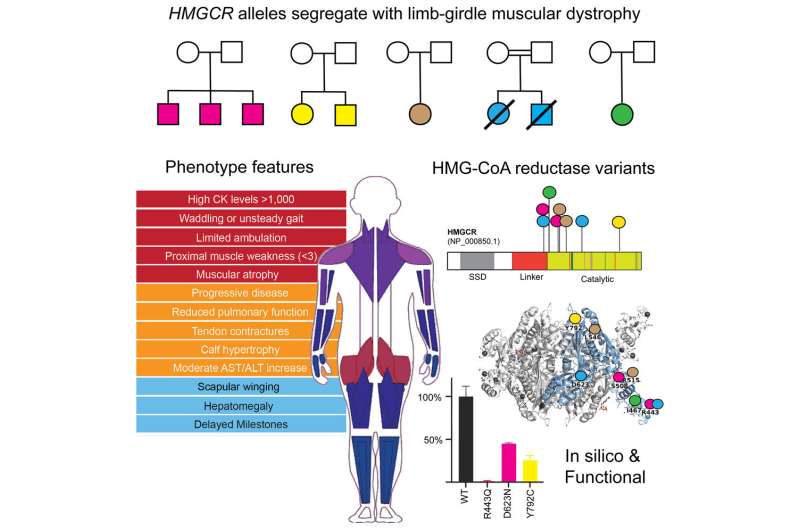This article has been reviewed according to Science X's editorial process and policies. Editors have highlighted the following attributes while ensuring the content's credibility:
fact-checked
peer-reviewed publication
trusted source
proofread
Genetic discovery leads to diagnoses of 9 people with rare form of muscular dystrophy

Nine people around the world who have been living with unexplained, muscular dystrophy-like symptoms may now have an answer for what is causing the progressive muscle weakness in their body's mid-section, arms and legs.
In a new discovery, a collaborative team of scientists led by researchers at Mayo Clinic's Center for Individualized Medicine has pinpointed alterations in a single gene deep inside these people's genetic blueprint as the root cause of their ultra-rare disorder, known as limb-girdle muscular dystrophy. For some, the onset of debilitating muscle-wasting symptoms began in childhood, while others started having trouble walking, running, climbing stairs and breathing in adulthood.
The new study describing their discovery is published in The American Journal of Human Genetics.
"This is an example of how research uses data and genome sequencing to provide patients with a real answer for what's causing their symptoms," says Eric Klee, Ph.D., Midwest associate director of research and innovation at the Mayo Clinic Center for Individualized Medicine. Dr. Klee is a lead author of the study.
The scientists found that each of the nine people across five families has altered copies of the HMGCR gene. As Dr. Klee explains, most people have two copies of every gene—one from each parent. Typically, when one copy of a gene is altered, the other normal copy may be sufficient to compensate for the defective one. In these patients' cases, however, both copies are altered with different abnormalities.
The HMGCR gene contains instructions for making an enzyme called HMG-CoA reductase. This enzyme is involved in the production of cholesterol and other substances that are essential for building healthy muscles and cell membranes, producing hormones and absorbing fats.
Dr. Klee emphasizes that this enzyme pathway can also be linked to non-genetic, muscle-related problems that resemble limb-girdle muscular dystrophy. For example, when a person has too much cholesterol, which increases their risk of heart disease, their health care team may recommend they take cholesterol-lowering drugs, called statins, that target this enzyme pathway.
"For decades it has been known that inhibiting this enzyme with statin drugs can lead to myopathy, or muscle damage, as a rare side effect," Dr. Klee says. "Now, for the first time, we have provided evidence of a genetic muscular dystrophy caused by partial dysfunction of this enzyme."
He says clinical laboratories can now routinely interrogate this gene to identify more patients with limb-girdle muscular dystrophy.
"We can now give them a sense of what to expect and pair them with similarly affected people," Dr. Klee adds.
Since their discovery, the researchers have begun investigating treatment opportunities for patients affected by limb-girdle muscular dystrophy and those with statin-induced myopathy.
More information: Joel A. Morales-Rosado et al, Bi-allelic variants in HMGCR cause an autosomal-recessive progressive limb-girdle muscular dystrophy, The American Journal of Human Genetics (2023). DOI: 10.1016/j.ajhg.2023.04.006

















